Senate Democrats criticize SCOTUS 'shadow docket' in hearing; Republicans see attempt at justice intimidation

Image from Shutterstock.
Is the U.S. Supreme Court’s “shadow docket” of emergency orders and summary decisions being misused in a way that undermines the court’s legitimacy? Or are Democrats who are criticizing the docket trying to intimidate the justices?
Those were among the charges lobbed during a Senate Judiciary Committee hearing Wednesday on the Supreme Court’s shadow docket and its shadow docket refusal to block the controversial Texas abortion law that bans abortions after about six seeks of pregnancy.
Law.com Law360, Roll Call and SCOTUSblog are among the publications with coverage; How Appealing links to additional stories and recorded testimony.
Senate Judiciary Committee Chairman Sen. Dick Durbin, a Democrat in Illinois, said in his opening statement the shadow docket is undermining claims that the Supreme Court is insulated from politics.
“In recent years, the Supreme Court has started to use the shadow docket for more political and controversial decisions with results that appear on their face to be ideologically driven,” Durbin said.
But Republicans saw the hearing as a well-timed effort to highlight the Texas abortion case, as well as another case before the Supreme Court involving a Mississippi law that bans abortions after 15 weeks of pregnancy.
“It’s clear that this is part of a concerted effort to intimidate and bully the members of the Supreme Court,” said Republican Sen. John Cornyn of Texas.
Republicans also criticized the shadow docket terminology; several said critics used the term because of its “nefarious” connotations, according to SCOTUSblog.
“Shadow docket, that is ominous. Shadows are really bad, like really, really bad,” said Republican Sen. Ted Cruz of Texas.
But Stephen Vladeck, a professor at the University of Texas School of Law, defended the term in prepared testimony.
“Rulings on the ‘shadow docket’ typically come after no more than one round of briefing (and sometimes less), are usually accompanied by no reasoning (let alone a majority opinion), invariably provide no identification of how (or how many of) the justices voted, and can be handed down at all times of day—or, as has increasingly become the norm, in the middle of the night,” he said.
“Owing to their unpredictable timing, their lack of transparency, and their usual inscrutability, these rulings come both literally and figuratively in the shadows,” Vladeck said.
Vladeck provided numbers to show how shadow docket action is increasing. He focused on four types of grants of emergency relief: stays and injunctions that are granted or vacated. During the October 2020 term, which ends Oct. 3, there have been 20 grants of these types of emergency relief. During the October 2005 term, which was the first for Chief Justice John G. Roberts Jr., there were six.
Democratic Sen. Mazie Hirono of Hawaii asked whether anything ideological was going on with the rulings, according to Law.com coverage of Vladeck’s testimony.
“Yes,” Vladeck replied. “They are far more homogeneously ideological than the merits docket. These are all breaking down on classic ideological grounds.”
Write a letter to the editor, share a story tip or update, or report an error.


